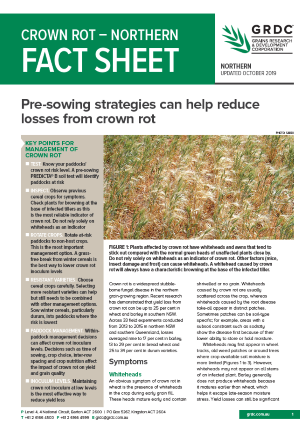Crown Rot - Northern
Crown Rot - Northern
Published: 01 Oct 2019
Crown rot is a widespread stubbleborne fungal disease in the northern grain-growing region. Recent research has demonstrated that yield loss from crown rot can be up to 25 per cent in wheat and barley in southern NSW.
Key points for management
- TEST. Know your paddocks’ crown rot risk level. A pre-sowing PREDICTA® B soil test will identify paddocks at risk
- INSPECT. Observe previous cereal crops for symptoms. Check plants for browning at the base of infected tillers as this is the most reliable indicator of crown rot. Do not rely solely on whiteheads as an indicator
- ROTATE CROPS. Rotate at-risk paddocks to non-host crops. This is the most important management option. A grassfree break from winter cereals is the best way to lower crown rot inoculum levels
- RESISTANT VARIETIES. Choose cereal crops carefully. Selecting more resistant varieties can help but still needs to be combined with other management options. Sow winter cereals, particularly durum, into paddocks where the risk is lowest
- PADDOCK MANAGEMENT. Withinpaddock management decisions can affect crown rot inoculum levels. Decisions such as time of sowing, crop choice, inter-row spacing and crop nutrition affect the impact of crown rot on yield and grain quality
- INOCULUM LEVELS. Maintaining crown rot inoculum at low levels is the most effective way to reduce yield loss.
Download PDF
Region: North

